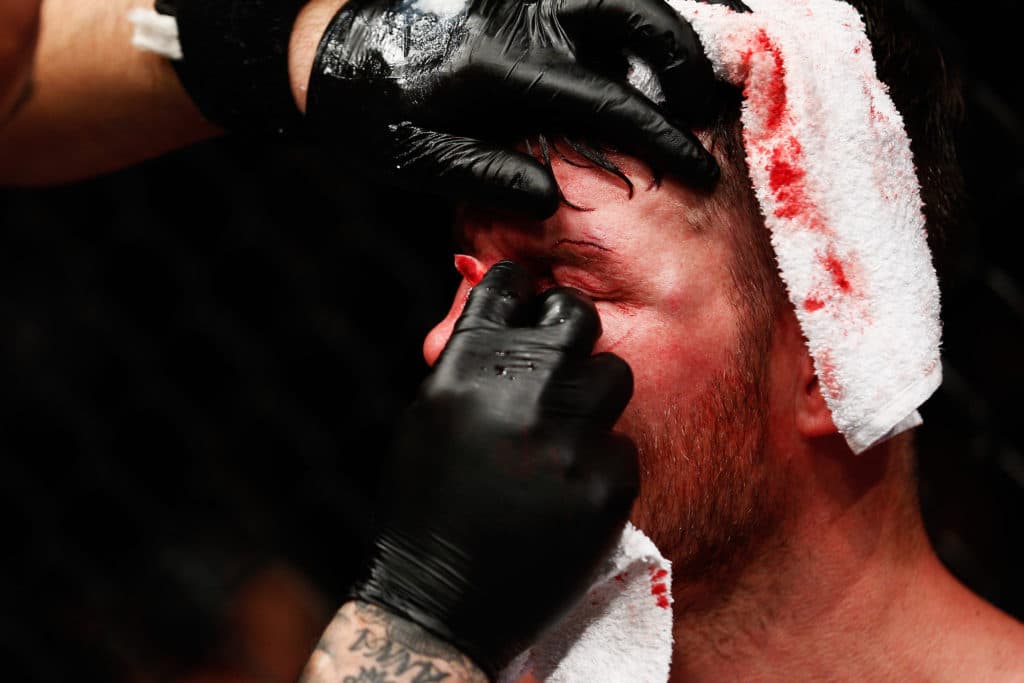In combat sports such as boxing, mixed martial arts (MMA), and kickboxing, a cutman is a crucial fighter’s corner team member. Cutmen are responsible for managing cuts and swelling on a fighter’s face during a bout to prevent the injury from escalating to a point where it affects the fighter’s vision.
Cutmen must have a strong understanding of anatomy, physiology, and wound care and the ability to work quickly and calmly under pressure. In this article, we will explore the role of a cutman in combat sports, including their duties, training, and career prospects.

Table of contents
- Who is a Cutman?
- What Does a Cutman Do?
- What qualifications does one need to become a cutman?
- What are some of the tools and supplies that a cutman uses to treat injuries during a fight?
- What is the Job and Salary Outlook of a Cutman?
- Is a career as a cutman worth it?
- Frequently Asked Questions
- Conclusion
- References
- Recommendations
Who is a Cutman?
A cutman is a member of a fighter’s corner team in combat sports, such as boxing, kickboxing, and mixed martial arts (MMA). Their primary responsibility is to manage cuts, swelling, and other injuries on a fighter’s face during a bout.
Cutmen work quickly and efficiently to prevent injuries from escalating to a point where they affect the fighter’s vision or cause the bout to be stopped prematurely. They must have a deep understanding of anatomy, physiology, and wound care and the ability to work calmly under pressure.
Cutmen are an integral part of a fighter’s support team and are crucial in ensuring their safety and success in the ring.
You should see this article: What is the Hardest Year of High School? How to Scale Through.
What Does a Cutman Do?
A cutman is responsible for managing cuts, swelling, and other injuries on a fighter’s face during a bout in combat sports. Their main objective is to keep the soldier safe and prevent any injuries from escalating to a point where they could affect the fighter’s vision or cause the bout to be stopped prematurely.
Cutmen work quickly and efficiently to treat cuts and swelling, using a variety of techniques such as applying ice or cold water to the affected area, using a solution of adrenaline and water to reduce bleeding, and applying a coagulant agent such as Vaseline or petroleum jelly to protect the cut and prevent further bleeding.
Cutmen must have a deep understanding of anatomy, physiology, and wound care, as well as solid communication and interpersonal skills to work closely with fighters, trainers, and other members of the corner team. They are crucial in ensuring the fighter’s safety and success in the ring.
Have you seen this article: What is a Quaker School? (Full Explanation with FAQs)
What qualifications does one need to become a cutman?
There is no formal educational or training requirement to become a cutman, but there are specific qualifications that can help individuals gain a foothold in the field.
Firstly, a strong understanding of anatomy, physiology, and wound care is essential. This knowledge can be gained through formal education in sports medicine, a related field, or practical experience working in a medical setting.
Additionally, experience in combat sports is highly valued, as it provides insight into the specific types of injuries cutmen are likely to encounter during a bout. This experience can be gained through martial arts, boxing, or other combat sports training.
Finally, cutmen typically gain experience and build a reputation by working with fighters and trainers at the local level before advancing to more significant events and more high-profile fights. Good communication and interpersonal skills and the ability to work calmly under pressure are also essential qualities for a cutman.
Check out this article: LNAT Universities 2023| Universities that Require an LNAT
What are some of the tools and supplies that a cutman uses to treat injuries during a fight?
A cutman uses various tools and supplies to treat injuries during a fight. These include:
- Enswell: An enswell is a small metal tool that applies pressure to a swollen area. It is typically stainless steel and shaped like a small horseshoe.
- Cotton Swabs: Cotton swabs apply coagulant agents such as adrenaline to stop bleeding.
- Ice Pack: Ice packs for reducing swelling and bruising.
- Vaseline: Vaseline or petroleum jelly to protect cuts from further damage and to prevent bleeding.
- Adrenaline Solution: Adrenaline solution is a coagulant agent to stop bleeding.
- Sterile Gauze: Sterile gauze to clean and dress wounds.
- Styptic Pencil: A styptic pencil stops bleeding from minor cuts.
- Medical Tape: Medical tape to secure bandages and gauze.
- Scissors: Scissors to cut gauze and tape it to the appropriate size.
- Water: Water to clean wounds and to wet the enswell before applying it to a swollen area.
These tools and supplies are typically in a cutman’s kit for easy access during a fight.
Read this article: What is Enrichment in School? (Full Explanation with FAQs)
What is the Job and Salary Outlook of a Cutman?
A cutman is a combat sports team member responsible for preventing and treating cuts and bruises on fighters during matches. While cutmen are essential to a combat sports team, it is a part-time job for most people. Many cutmen work freelance, and their income can vary depending on the number of fights they work on and the level of competition they work with.
According to Payscale, the average salary for a cutman in the United States is around $40,000 annually. However, this figure can vary depending on factors such as experience, reputation, and the level of competition they work with. Cutmen who work with high-level fighters can earn significantly more than those who work with amateurs or lower-level professionals.
The job outlook for cutmen is difficult to gauge as it is not a standardized or regulated profession. However, as long as combat sports continue to be popular and fighters continue to get injured during matches, there will likely be a demand for cutmen. That being said, competition for jobs may be high, and cutmen may need to establish a reputation within the combat sports community to secure regular work.
Have you seen this article: What Is Executive Golf Course? 2023 Enrollment
Is a career as a cutman worth it?
Whether a career as a cutman is worth, it depends on several factors, including your interests, skills, and career goals. Here are some factors to consider:
Passion for combat sports
Cutmen work with fighters in combat sports such as boxing, MMA, and kickboxing. If you are passionate about these sports and enjoy being part of the action, a career as a cutman could be a good fit for you.
Comfort with blood and injuries
Cutmen treat cuts and bruises on fighters, involving blood and other bodily fluids. If you are squeamish or uncomfortable around these types of injuries, a career as a cutman may not be for you.
You should see this article: In What Country Is It Easiest to Become a Doctor?
Availability of work
As mentioned earlier, cutmen often work freelance, and their income can vary depending on the number of fights they work on and the level of competition they work with. Establishing a regular schedule and income as a cutman can be challenging, especially when starting.
Career progression
There is little room for career advancement as a cutman, as it is a specialized role within a combat sports team. However, some cutmen may be able to expand their skill set and take on roles such as cornerman or trainer.
A career as a cutman can be rewarding for those who are passionate about combat sports and enjoy being part of the action. However, there may be better fits for some, and it can be challenging to establish a steady income and career progression.
You should see this related article: What does an Electric Filter do? (Full explanation with FAQs)
Frequently Asked Questions
A cutman manages cuts, swelling, and other injuries on a fighter’s face during a bout. They work to prevent these injuries from escalating to a point where they affect the fighter’s vision or cause the bout to be stopped prematurely.
There need to be formal education or training programs to become a cutman. However, most cutmen have a background in combat sports or a related field and often receive on-the-job training or mentorship from experienced cutmen.
Cutmen use various techniques to manage cuts and swelling, including applying ice or cold water to the affected area, using a solution of adrenaline and water to reduce bleeding, and applying a coagulant agent such as Vaseline or petroleum jelly to protect the cut and prevent further bleeding.
In addition to their wound care knowledge, cutmen must have strong communication and interpersonal skills, as they must work closely with fighters, trainers, and other members of the corner team. They must also be able to work quickly and calmly under pressure, as bouts can be intense and fast-paced.
Cutmen can have a long and successful career in combat sports, with the potential to work with top fighters and earn a good income. However, the field is highly competitive, and cutmen must build a strong reputation and network to secure steady work.
Conclusion
The role of a cutman in combat sports is essential to the safety and success of fighters. They play a critical role in managing cuts and swelling on a fighter’s face during a bout, allowing the soldier to continue fighting without the injury affecting their vision or causing the bout to be stopped prematurely.
Cutmen must have a deep understanding of anatomy, physiology, and wound care and the ability to work quickly and calmly under pressure. They are an integral part of a fighter’s corner team, and their expertise and skills can make all the difference in a fight. With the increasing popularity of combat sports, the demand for cutmen is likely to remain strong in the coming years.
Check out this article: What Are the Different Types of Executive-Level Jobs in 2023? How to Apply.



